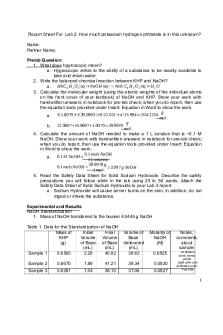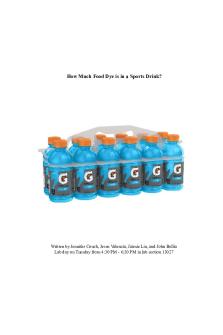Lab 4: How much Hydrogen peroxide is in Commercial Hydrogen Peroxide Solution? PDF

| Title | Lab 4: How much Hydrogen peroxide is in Commercial Hydrogen Peroxide Solution? |
|---|---|
| Author | Jaeda Smith |
| Course | Quantitative Analytical Chemistry Laboratory |
| Institution | Kennesaw State University |
| Pages | 5 |
| File Size | 174.4 KB |
| File Type | |
| Total Downloads | 27 |
| Total Views | 158 |
Summary
Lab 4: How much Hydrogen peroxide is in Commercial Hydrogen Peroxide Solution?
Finding the concentration of Hydrogen Peroxide in commercial bottle sold and distributed....
Description
LAB 4 REPORT SHEET: How much hydrogen peroxide is in commercial hydrogen peroxide? Date of the experiment: Your Name: Your Partner’s Name(s): (This is a word document – fill in your answers and add space as needed) Prelab Questions: 1. You have used a graduated cylinder to measure stock MnO4- solution and a plastic bottle to prepare a working solution of MnO4- that you will later use to determine the amount of hydrogen peroxide. Justify the use of a graduated cylinder and a plastic bottle for preparing MnO4- . We will use a graduated cylinder because we do not need an exact value of the volume, only an approximate value. The volumes don’t need to be precise because we will be standardizing the solution. 2. Define primary standard, endpoint and equivalence point. . Primary standard- reagent that is extremely pure and stable, has no water of hydration, and has a high molecular weight End- point- the point at which an indicator changes color and a titration is stopped. Equivalence point- the point at which the chemically equivalent quantities of reactants has mixed chemically, estimated from stoichiometry. Reference: Quantitative Chemical Analysis 8th Edition: “Harris” pg. 22, 23 3. In the experiment 25 mL of 3 M H2SO4 is used. Will that volume be measured with a 25.00 mL pipet or a graduated cylinder? The volume will be measured with a graduated cylinder to measure the 25mL of 3 M H2SO4, because it will be measured approximately to dilute it. We will not need a precise measurement which would be given by the 25.00 mL pipet. 4. A 25.00 mL H2O2 solution required 22.50 mL of 0.01881 M MnO4- for titration to the end-point. Given that the original H2O2 was diluted 1 in 20 before titration with the MnO4-, (i) what is the molarity of the diluted H2O2? (ii) What is the molarity of the original H2O2 solution? (iii) What is the % w/w of H2O2 in the original solution, assuming a solution density of 0.9998 g/mL? show work. (i.)
0.01881mol L
× 0.02250L = 0.0004232 mol MnO4-
5:2 ratio between H2O2 and MnO40.0004232 MnO4- × 0.001058mol H₂O₂ 0.02500L
5mol H₂O₂ 2mol MnO₄⁻
= 0.001058 mol H2O2
= 0.04232M
0.04232M × 20 dilutions = 0.8465M H2O2 diluted (ii.) 2 mol MnO4- = 0.001058 mol H2O2 0.001058mol H₂O₂ 0.02500L
= 0.04232M H2O2 original
(iii.) 0.8465mol H₂O₂ 1L
A.
1L
1mL
× 1000mL × 0.9998g ×
34.014g 1mol H₂O₂
× 100 = 2.879% H2O2
Calculation of the volume of KMnO4 used to prepare a roughly 0.02 M solution. Stock solution concentration: ___________ M
(0.12M) (V1) = (0.02M) (250mL) V1 = 25mL
B.
Table 1. Standardization of KMnO4 using Na2C2O4 as the primary standard. Trial 1
Trial 2
Trial 3
Trial 4
Na2C2O4, g
0.2182g
0.2238g
0.2244g
X
Moles Na2C2O4 Final buret di Initial buret
0.00163moles
0.00167moles
0.00168moles
X
35.65mL
36.45mL
0.46mL
X
0.95mL 0.65mL 36.35mL di Volume 34.70mL 35.80mL 35.89mL d L Moles 0.000651moles 0.000688moles 0.000670moles KM MolarityOof 0.0188M 0.0192M 0.0186M KMnO4 Mean, M 0.0191M SD 0.0004M
X X X X
If any trial is removed from the calculation of mean and standard deviation explain here: Trial 4 was removed from the calculation of mean and standard deviation because when conducting the experiment our stopcock fell out of the buret and all of the potassium permanganate splashed out of the buret rapidly. Therefore, were not able to record the accurate endpoint for trial 4. Sample calculations of Table 1 using Trial 1 using equation editor in Word. (Moles Na2C2O4, Moles KMnO4, Molarity of KMnO4) Moles Na2C2O4: 0.2182g ×
1mol g
133.998mol Na₂C₂O₄
Moles KMnO4: 0.00163 moles Na2C2O4 × Molarity of KMnO4:
0.000651 moles KMnO₄ 0.03470L
= 0.00163 moles Na₂C₂O₄ 2mol KMnO₄
5mol Na₂C₂O₄
= 0.000651 moles KMnO4
= 0.0188M KMnO4
C.
Table 2. Analysis of 25-mL aliquots of commercial solution of hydrogen peroxide using standardized KMnO4. Molarity of KMnO4:
0.0191M
0.0004 (M±SD)
±
Trial 1
Trial 2
Trial 3
Trial 4
Final buret reading
32.45mL
32.24mL
32.10mL
X
Initial buret reading
0.95mL 31.50mL
0.35mL 31.89mL
0.45mL 31.65mL
X X
6.02 × 10-4 moles 1.51 x 10-3 moles
6.09 × 10-4 moles 1.52 x 10-3 moles
6.05 × 10-4 moles 1.51 x 10-3 moles
X
Moles/L H2O2
0.0479 moles/L
0.0476 moles/L
0.0477 moles/L
X
g/L diluted H2O2
1.63 g/L
1.48 g/L
1.62 g/L
X
g/L undiluted H2O2
2.05 g/L
2.07 g/L
2.05 g/L
X
3.15%
3.49%
3.17%
X
-
Volume MnO4 d Moles MnO4- used Moles H2O2 found
% H2O2 in % solution Mean, % w/w
X
3.27%
SD
0.1907M
If any trial is removed from the mean and standard deviation calculation, explain here: Trial 4 was not included in the calculation for the mean weight percentage and standard deviation because we ran out of time and were only able to conduct 3 trials. We calculated the mean weight percentage and standard deviation with the 3 successful trials we conducted. Sample calculation of Table 2 using one trial: (Moles KMnO4, Moles H2O2, Moles/L, g/L diluted, g/L undiluted, %H2O2) Moles KMnO4: 0.0191M × 31.50mL ×
1L 1000mL
Moles H2O2: 6.02 × 10-4 moles KMnO4 ×
= 6.02 x 10-4 moles KMnO4
5mol H₂O₂ 2mol KMnO₄
= 1.51 x 10-3 moles H2O2
Moles/L: 1.51 x 10-3 ÷ 0.03150L = 0.0479 moles/L g/L diluted: 1.51 x 10-3 ×
34.014g H₂O₂ 1
×
1 0.03150L
= 1.63 g/L H2O2 diluted
g/L undiluted: 1.51 x 10-3 × % H2O2:
34.014g H₂O₂ 1
(34.014g H₂O₂)(0.00151moles H₂O₂) 1.63g 2 2 H O diluted L
×
1 0.025L
= 2.05g/L H2O2 undiluted
× 100 = 3.15%
Post-lab Questions: 1.
What changes would you make to the experiment to improve the accuracy and precision? To improve the accuracy and precision we would want to use the volumetric pipet that gives us a reading of certainty to 2 decimal places rather than a graduated cylinder, which gives us only an approximate measurement. We could also improve the precision by using a more dilute solution of H2O2 so we could experimentally determine the endpoint more accurately. 2.
Verify by calculation that a 3% hydrogen peroxide solution of a density approximately 1.000g/mL is about 0.88M. 3
34.01g/mol
= 0.088 mol H2O2
0.088mol = 0.88moles 100mL 0.88moles = 0.88M 1L
H2O2
3.
State two possible reasons why the KMnO4/H2O2 titration was carried out at elevated temperatures. We needed heat for our reaction to occur since it is not favored at room temperature. The reaction between Na2C2O4 and KMnO4 requires heat to be put in because it is a redox reaction. At higher temperatures the equilibrium is pushed to the right. Elevating the temperature of the titration also helped to speed up the reaction taking place, otherwise it would take more time and more volume of the titrant delivered. 4. Why was an indicator not necessary for these titrations? An indicator was not necessary for these titrations because the potassium permanganate acted as its own indicator for the solution because of its dark purple color. 5.
Write out the two reactions involved and indicate which species is the oxidant, which is the reductant, which is oxidized and which is reduced for both reactions. 5C2O42- (Reducing agent, oxidized) + 2MnO4- (Oxidizing reagent, reduced) + 16H+ → 10CO2 + 2Mn2+ + 8H2O 5H2O2 (Reducing agent, oxidized) + 2MnO4- (Oxidizing agent, reduced) + 6H+ → 2Mn2+ + 5O2 + 8H2O...
Similar Free PDFs

Atomic Hydrogen Welding
- 1 Pages

Grundstoffer som hydrogen m.m.
- 1 Pages
Popular Institutions
- Tinajero National High School - Annex
- Politeknik Caltex Riau
- Yokohama City University
- SGT University
- University of Al-Qadisiyah
- Divine Word College of Vigan
- Techniek College Rotterdam
- Universidade de Santiago
- Universiti Teknologi MARA Cawangan Johor Kampus Pasir Gudang
- Poltekkes Kemenkes Yogyakarta
- Baguio City National High School
- Colegio san marcos
- preparatoria uno
- Centro de Bachillerato Tecnológico Industrial y de Servicios No. 107
- Dalian Maritime University
- Quang Trung Secondary School
- Colegio Tecnológico en Informática
- Corporación Regional de Educación Superior
- Grupo CEDVA
- Dar Al Uloom University
- Centro de Estudios Preuniversitarios de la Universidad Nacional de Ingeniería
- 上智大学
- Aakash International School, Nuna Majara
- San Felipe Neri Catholic School
- Kang Chiao International School - New Taipei City
- Misamis Occidental National High School
- Institución Educativa Escuela Normal Juan Ladrilleros
- Kolehiyo ng Pantukan
- Batanes State College
- Instituto Continental
- Sekolah Menengah Kejuruan Kesehatan Kaltara (Tarakan)
- Colegio de La Inmaculada Concepcion - Cebu













